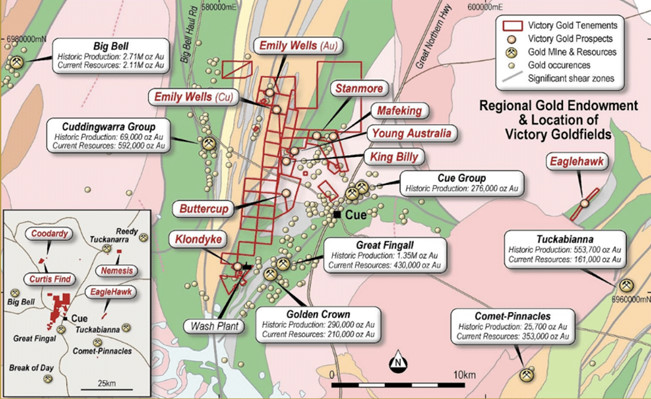Regional structures are in compression along most of their length and are mostly unmineralized. However, divergence or bending of the structure can cause tensional zones to form. If hot hydrothermal or magmatic fluids are present the decreased pressure and temperature gradients can allow gold to precipitate from the fluids at those divergent locations.
During fieldwork and mapping programs, Victory Metals has identified many workings that are yet to be recorded in the Inventory of Abandoned Mine Sites in Western Australia Database. For example, several unrecorded old workings have recently been found near the Coodardy deposit and the Stanmore prospect.
Victory Metals’ database of multi-element assays from the systematic recording and sampling of mullock dumps around all old workings is in progress.

Additional workings are expected to be added. In time, these workings will be prioritised for drilling using their regional and geochemical characteristics, including:

Gold mining of hydrothermal quartz veins hosted by the Cue tonalite granitoid rocks has historically taken place at Victory Buttercup. There are old abandoned shafts and stopes around the main workings of Victory (Buttercup East) and Buttercup West (Pamela) mines.
Two soil anomalies occur within the M20/305 tenement. The first is the south-east anomaly, a 400 m by 100 m north-north-east trending zone of gold soil anomaly (greater than 10 ppb) within iron rich residual hard cap duricrust and pitted (ex-sulphide) quartz vein remnants. The anomaly coincides with an interpreted linear geological structure of interest. The second anomaly is a discrete gold in soil anomaly with a peak of 330ppb.
Nearby to the east of M20/305 tenement is the M20/288 tenement which hosts the historical mines of Young Colonial, New England and Welcome.

The Mafeking prospect is located in an area that consists of multiple historical mines. The reefs are intersecting and very close together, which created so many small mines within a confined area.
A number of shafts were sunk upon the quartz reef which strikes north-east and dips to the north-west. The regolith at Mafeking is characterised by a surficial lateritic hardpan underlain by oxidised weathered bedrock transitioning to fresh Cue tonalite granite at around 50 m depth. The weathered granite is the bedrock host to the quartz veins.
Adjoining the Mafeking to the east is a parallel reef in oxidised Cue granite (altered to white kaolin clay), which was worked by a series of shallow shafts in the soft weathered bedrock. The workings cover a strike length of 340 m and remain untested by modern exploration. This considerable strike length warrants systematic drilling to test its potential.

Mining lease application M20/543 includes a large number of historical gold workings, notably Stanmore, Retreat and Union Jack. All are located in granite hosting north-east striking north-west dipping quartz veins in a shear zone. Thin mafic schist or amphibolite units are locally associated with the mined quartz veins/shears. Average mined grades from the historic workings range from 9g/t to 29 g/t Au.
The workings comprise shallow shafts and stopes with approximate depths of 10 m to 20 m. There are also a few other shallow shafts at Retreat. An area around the Union Jack Workings has more recently been scraped for metal detecting, and the topsoil/overburden stockpiled.
Exploration potential exists within M20/543 for infill and extensional drilling to test the identified shallow oxide gold mineralisation which remains open in all directions along strike, plus structural repetitions/additional quartz vein lodes to either side, and at depth.

Victory’s Curtis Find project at the M20/327 tenement is renowned as a rich prospector dry blowing area and still yields gold nuggets. This is an area of great interest geologically with visual lode structures and has strong untested potential as a gold exploration target.

Victory’s Emily Wells East at tenement E20/871 was drilled in 1995, however requires follow up exploration.